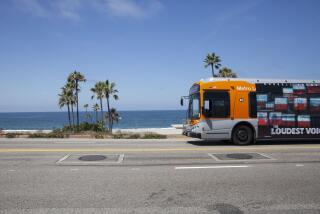Finding a Train of Thought in Bern
- Share via
I stared at the departure board in the Bern railway station and pondered my immediate future. Within the hour there was a train to Basel on the Rhone and another to lakeside Lucerne.
Geneva was one hour and 43 minutes away, Zurich one hour and 11.
In my hand was a Eurailpass, which meant unlimited miles. I had rarely felt richer or less encumbered with plans.
“May I help you?” asked a passer-by. He wore the uniform of a Swiss railroad conductor.
“Perhaps,” I answered, expanding the game. “Where would you go today if you had a Eurailpass?”
He pulled an International Herald Tribune from his pocket.
“That is easy,” he said. “I would go to Milan. I was reading a review of ‘Madama Butterfly’ at La Scala and it is not sold out for tonight. If you like opera. . . .”
“Yes,” I replied, the matter settled.
“The train departs at 10:21,” he said, tapping his watch.
“Hurry. Auf Wiedersehen. Ciao .”
Getting an opera tip from a railroad man is the sort of pleasant encounter that has made me feel at home in the Bern train station.
Other European stations--such as the massive monument that Mussolini built in Milan--are grander works of art. And other station restaurants--led by Le Train Bleu at Paris’ Gare de Lyon--offer more belle epoque gilt.
But nowhere have I been as captivated by a station’s small-town charm as in Bern, the capital of Switzerland.
The station is a model of efficiency, as befits its punctual inhabitants. Trains are computer-controlled and famed for their on-time record. Corridors from the train platforms open into a soaring three-story space that is the bright heart of the station--a clutch of restaurants, shops and traveler services that seem to fill most of life’s needs.
You find post-office facilities, push-button stock reports, barber and beauty shops, restrooms with baths or showers, a Laundromat, a fitness room, a cobbler, a pharmacy, a florist, a hotel booking office and the Central Tourist Office of Bern.
There is even a six-room jail, used mostly as a holding area for the transfer of prisoners, although, a station policeman told me, they do haul in the odd rowdy drunk.
My first visit to Bern was in midwinter and more than 10 years ago. I had been riding a train since leaving London. The Bern station seemed as warm and cozy as a ski resort, and--with my blotched record on the slopes--a much safer place to be.
The air was laced with the smells of rich coffee, hot chocolate, spicy sausages and fresh-baked bread. Someone was playing a zither. At the top of the escalators, the medieval city shimmered through beaded curtains of snow.
Everything seemed perfect, except that the dollar was slipping against the Swiss franc that season. When I stopped to cash a traveler’s check, the banker punched his calculator and looked up with kind, sad eyes.
“A pity,” he murmured, counting out the francs. Who says the Swiss have no passion? I knew that I would return to this city.
Located midway between the international summit center of Geneva and the serious banking of Zurich, Bern leads a storybook life. Its emblem is the bear, and real ones frolic in 15th-Century bear pits on Barenplatz, a short trolley ride from the station.
The 14th Century is entrenched in the station itself, where remnants of Bern’s medieval outer walls were discovered during excavation for expansion. Those rough outcroppings and arches were left in place to create a dramatic waiting area. Backpacking travelers perch there with guitars. It’s a natural place to lean skis.
My most recent visit to Bern was last June. The town’s trademark red geraniums spilled from window boxes. At the station, I bought Toblerone chocolate bears from the elegant Confisserie Modinger and candy shaped like ice hockey boots at Merkur Market.
From country-fair kiosks on the ground floor, I was able to resist earrings shaped like cowbells and too-large-to-pack music boxes, but I could not resist a leather holder for my Swiss army knife.
In the Kuttel Tobacco emporium, on the marble-floored main level, the proud proprietor unlocked a cabinet to show me a collector’s item--an intricate briar-and-silver pipe made near Lucerne. The price was 900 Swiss francs, or about $600.
“This is the pipe that Swiss men put in their pocket when they wear traditional costumes,” she explained, turning it in the light. “We have to clean the silver a bit, eh?”
Ever tidy, the Swiss. And in Bern, ever helpful.
More to Read
Sign up for The Wild
We’ll help you find the best places to hike, bike and run, as well as the perfect silent spots for meditation and yoga.
You may occasionally receive promotional content from the Los Angeles Times.






